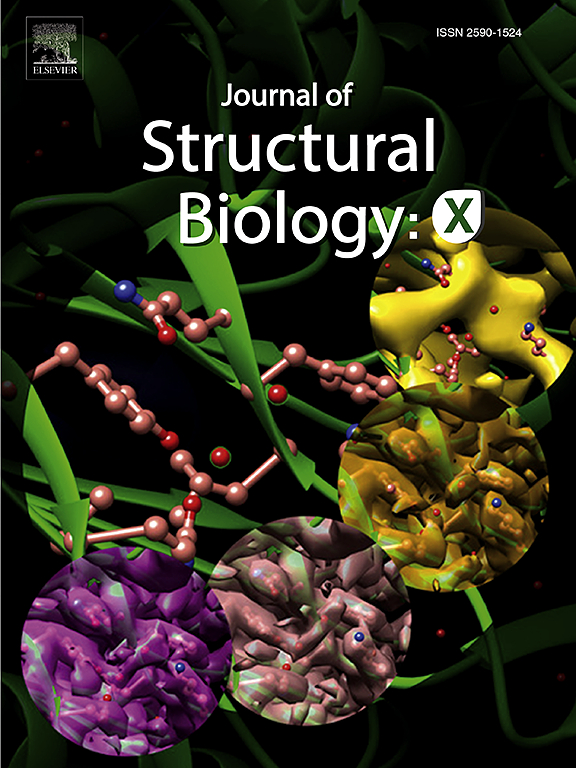Disulfide bonds enhance thermal stability and thumb region drives activity of the glycoside hydrolase 11 xylanase rMxylcd
IF 2.7
3区 生物学
Q3 BIOCHEMISTRY & MOLECULAR BIOLOGY
引用次数: 0
Abstract
Thermostable enzymes have significant advantages in industries, yet uncovering novel candidates with superior properties remains a scientific pursuit. This study identified rMxylcd, a glycoside hydrolase 11 family thermophilic xylanase from compost-soil metagenome, which exhibited a high specific activity of 5954 U·mg−1 at pH 5.5 and 80°C. rMxylcd was crystallized and diffracted to 1.5 Å resolution. Compared to the mesophilic xylanase Xyn II, rMxylcd exhibits a more compact architecture. Notably, B-factor analysis reveals a uniquely flexible thumb region, hinting at its critical role in the enzyme’s catalytic mechanism. rMxylcd contains two disulfide bonds in the thumb and the N-terminal regions. Breaking these disulfide bonds by mutagenesis has dramatically decreased activities and thermostability. Conversely, introducing an extra disulfide bond at the N-terminal region of its α-helix extended its half-life for more than five folds at 80°C. Our studies firmly establish that the disulfide bonds are essential for its high thermal stability and the flexibility of the thumb region is crucial for its activity. Comparing the rMxylcd crystal structure with the AlphaFold2-predicted model shows overall similarity, but the crystal structure offers higher local accuracy, especially in key functional regions. These findings not only deepen our understanding of the structure-function relationship of thermophilic xylanases but also inform a rational design of industrial enzymes.
二硫键增强热稳定性,拇指区驱动糖苷水解酶11木聚糖酶rMxylcd的活性。
耐热酶在工业上具有显著的优势,但发现具有优越性能的新型候选酶仍然是一项科学追求。本研究从堆肥-土壤元基因组中鉴定出糖苷水解酶11家族嗜热木聚糖酶rMxylcd,该酶在pH 5.5和80°C条件下的比活性为5954 U·mg-1。rMxylcd结晶,衍射至1.5 Å分辨率。与中温木聚糖酶Xyn II相比,rMxylcd具有更紧凑的结构。值得注意的是,b因子分析揭示了一个独特的灵活的拇指区域,暗示其在酶的催化机制中的关键作用。rMxylcd在拇指区和n端区含有两个二硫键。通过诱变破坏这些二硫键大大降低了活性和热稳定性。相反,在α-螺旋的n端区域引入一个额外的二硫键,在80℃时将其半衰期延长了5倍以上。我们的研究坚定地确立了二硫键对其高热稳定性和拇指区域的灵活性是至关重要的。将rMxylcd晶体结构与alphafold2预测模型进行比较,总体上相似,但晶体结构具有更高的局部精度,特别是在关键功能区域。这些发现不仅加深了我们对嗜热木聚糖酶结构-功能关系的认识,而且为工业酶的合理设计提供了依据。
本文章由计算机程序翻译,如有差异,请以英文原文为准。
求助全文
约1分钟内获得全文
求助全文
来源期刊

Journal of structural biology
生物-生化与分子生物学
CiteScore
6.30
自引率
3.30%
发文量
88
审稿时长
65 days
期刊介绍:
Journal of Structural Biology (JSB) has an open access mirror journal, the Journal of Structural Biology: X (JSBX), sharing the same aims and scope, editorial team, submission system and rigorous peer review. Since both journals share the same editorial system, you may submit your manuscript via either journal homepage. You will be prompted during submission (and revision) to choose in which to publish your article. The editors and reviewers are not aware of the choice you made until the article has been published online. JSB and JSBX publish papers dealing with the structural analysis of living material at every level of organization by all methods that lead to an understanding of biological function in terms of molecular and supermolecular structure.
Techniques covered include:
• Light microscopy including confocal microscopy
• All types of electron microscopy
• X-ray diffraction
• Nuclear magnetic resonance
• Scanning force microscopy, scanning probe microscopy, and tunneling microscopy
• Digital image processing
• Computational insights into structure
 求助内容:
求助内容: 应助结果提醒方式:
应助结果提醒方式:


